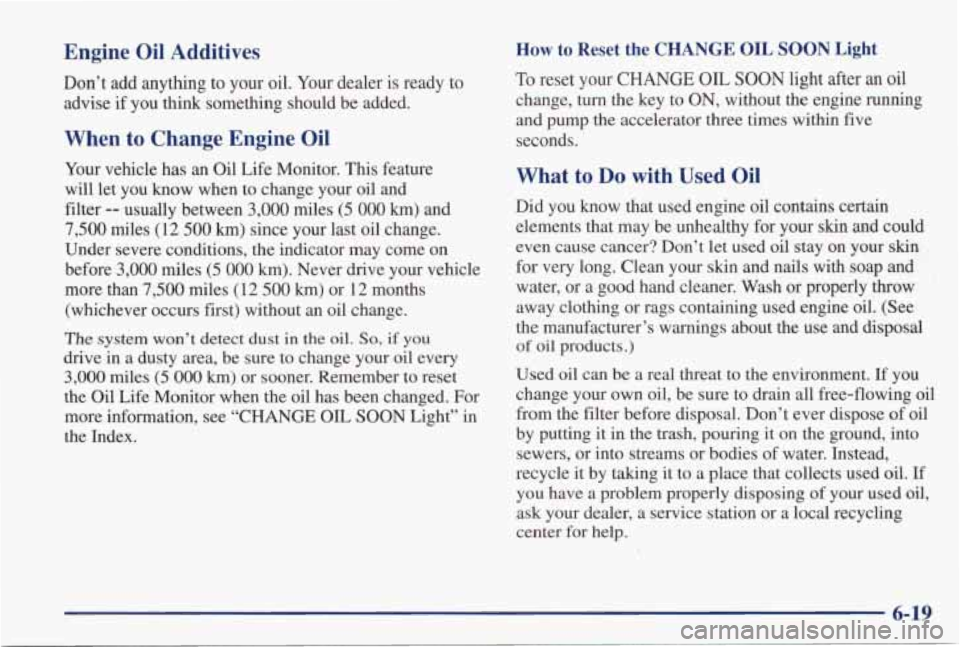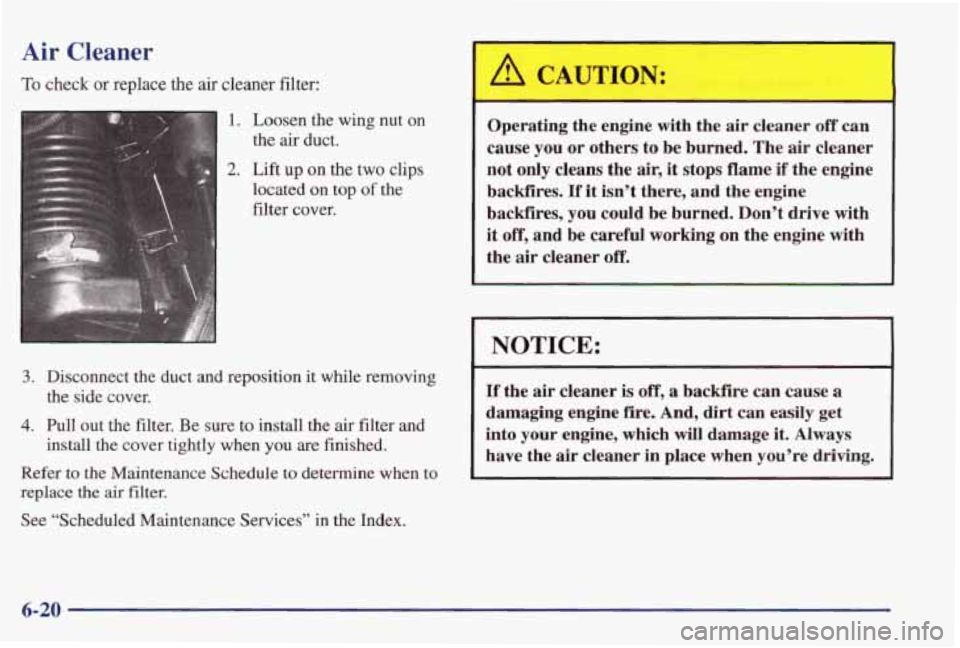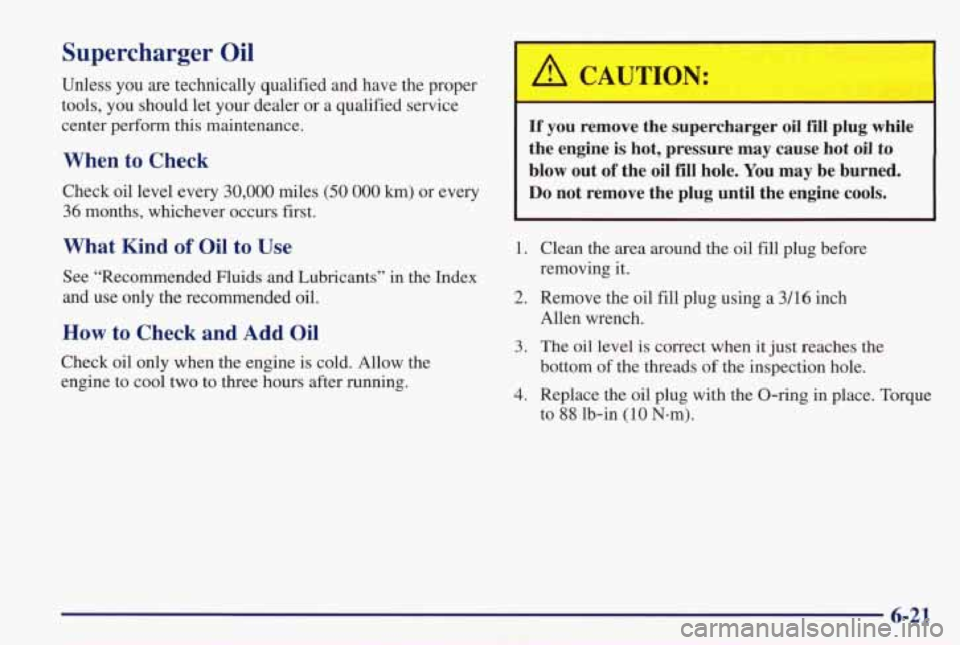Page 293 of 402

HOT
WEATHER
ImK
FOR THIS
--
RECOMMENDED SAE VISCOSITY GRADE EWGIWE OILS
FOR BEST FUEL ECONOMY AND COLD STARTINO, SELECT THE LOWEST
SA€ UlSCOSlll 6MDE OIL FOR THE EXPECTLD TEMPERATURE WE.
COLD
WEATHER
il UE I lbw-30
PREFERRED &ow 0°F (-1SoC)
DO NOT USE SAE 20W-50 OR ANY OTHER GRADE OIL NOT RECOMMENDED
3800 or 3800 Supercharged Engine
As shown in the chart, if you have the 3800 engine,
SAE 1OW-30 is best for your vehicle. However, you
can use
SAE 5W-30 if it’s going to be colder than
60°F (16°C) before your next oil change. When it’s
very cold, you should use
SAE 5W-30. These numbers
on an oil container show its viscosity, or thickness. Do
not use other viscosity oils, such as SAE 2OW-50.
NOTICE:
Use only engine oil with the American Petroleum
Institute Certified For Gasoline Engines
“Starburst”
symbol. Failure to use the
recommended
oil can result in engine damage not
covered
by your warranty.
GM Goodwrench@ oil meets all the requirements for
your vehicle.
If you are in an area where the temperature falls
below
-20°F (-29”C), consider using either an
SAE 5W-30 synthetic oil or an SAE OW-30 oil. Both
will provide easier cold starting and better protection
for
your engine at extremely low temperatures.
6-18
Page 294 of 402

Engine Oil Additives
Don’t add anything to your oil. Your dealer is ready to advise
if you think something should be added.
How to Reset the CHANGE OIL SOON Light
When to Change Engine Oil
Your vehicle has an Oil Life Monitor. This feature
will let you know when to change your oil and
filter
-- usually between 3,000 miles (5 000 km) and
7,500 miles (12 500 km) since your last oil change.
Under severe conditions, the indicator may come
on
before 3,000 miles (5 000 km). Never drive your vehicle
more than
7,500 miles (12 500 km) or 12 months
(whichever occurs first) without an oil change.
The system won’t detect dust in the oil. So, if you
drive in a dusty area, be sure to change your oil every
3,000 miles (5 000 km) or sooner. Remember to reset
the Oil Life Monitor when the oil has been changed. For
more information, see “CHANGE
OIL SOON Light” in
the Index.
To reset your CHANGE OIL SOON light after an oil
change, turn
the key to ON, without the engine running
and pump the accelerator three times within five seconds.
What to Do with Used Oil
Did you know that used engine oil contains certain
elements that may be unhealthy for your skin and could
even cause cancer? Don’t let used oil stay on your skin
for very long. Clean your skin and nails with soap and
water, or a good hand cleaner. Wash or properly
throw
away clothing or rags containing used engine oil. (See
the manufacturer’s warnings about the use and
disposal
of oil products.)
Used oil can
be a real threat to the environment. If you
change your own oil, be sure to drain
all free-flowing oil
from the filter before disposal. Don’t ever dispose of oil
by putting it in the trash, pouring it on the ground, into
sewers, or into streams or bodies of water. Instead,
recycle it by taking it to a place that collects used oil.
If
you have a problem properly disposing of your used oil,
ask your dealer, a service station or a local recycling
center for help.
6-19
Page 295 of 402

Air Cleaner
To check or replace the air cleaner filter:
1. Loosen the wing nut on
the air duct.
2. Lift up on the two clips
located
on top of the
filter cover.
3. Disconnect the duct and reposition it while removing
4. Pull out the filter. Be sure to install the air filter and
install the cover tightly when you are finished. the side cover.
Refer to the Maintenance Schedule to determine when
to
replace the air filter.
See “Scheduled Maintenance Services” in the Index.
I A CAUTION:
Operating the engine with the air cleaner off can
cause you
or others to be burned. The air cleaner
not
only cleans the air, it stops flame if the engine
backfires.
If it isn’t there, and the engine
backfires, you could be burned. Don’t drive with
it
off, and be careful working on the engine with
the air cleaner
off.
I NOTICE:
If the air cleaner is off, a backfire can cause a
damaging engine fire. And,
dirt can easily get
into your engine, which will damage it. Always
have the
air cleaner in place when you’re driving.
6-20
Page 296 of 402

Supercharger Oil
Unless you are technically qualified and have the proper
tools,
you should let your dealer or a qualified service
center perform this maintenance.
When to Check
Check oil level every 30,000 miles (50 000 km) or every
36 months, whichever occurs first.
What Kind of Oil to Use
See “Recommended Fluids and Lubricants” in the Index
and use only the recommended oil,
How to Check and Add Oil
Check oil only when the engine is cold. Allow the
engine to cool two to
three hours after running.
A CAUTION:
If you remove the supercharger oil fill plug while
the engine is hot, pressure may cause hot
oil to
blow out
of the oil fill hole. You may be burned.
Do not remove the plug until the engine cools.
1. Clean the area around the oil fill plug before
2. Remove the oil fill plug using a 3/16 inch
3. The oil level is correct when it just reaches the
bottom
of the threads of the inspection hole.
removing
it.
Allen wrench.
4. Replace the oil plug with the O-ring in place. Torque
to
88 lb-in (10 N-m).
6-21
Page 297 of 402

Automatic Transaxle Fluid
When to Check and Change
A good time to check your automatic transaxle fluid
level is when the engine oil is changed.
Change both the fluid and filter every
50,000 miles
(83 000 km) if the vehicle is mainly driven under one or
more of these conditions:
0 In heavy city traffic where the outside temperature
In hilly or mountainous terrain.
regularly reaches
90” F (32 O C) or higher.
0 When doing frequent trailer towing.
0 Uses such as found in taxi, police or delivery service.
If you do not use
your vehicle under any of these
conditions, the fluid and filter
do not require changing.
See “Scheduled Maintenance Services” in the Index.
How to Check
Because this operation can be a little difficult, you may
choose to have
this done at your Pontiac dealership
Service Department.
If you do
it yourself, be sure to follow all the
instructions here, or you could get a false reading on
the dipstick.
NOTICE:
Too much or too little fluid can damage your
transaxle.
Too much can mean that some of the
fluid could come out and fall on
hot engine parts
or exhaust system parts, starting a fire. Be sure to get an accurate reading if you check your
transaxle fluid.
6-22
Page 298 of 402
Wait at least 30 minutes before checking the transaxle
fluid level if you have been driving:
0 When outside temperatures are above 90°F (32" C).
0 At high speed for quite a while.
In heavy traffic -- especially in hot weather.
While pulling a trailer.
To get the right reading, the fluid should be at normal
operating temperature, which is
180°F to 200°F (82°C
to 93 " C).
Get the vehicle warmed up by driving about 15 miles
(24
km) when outside temperatures are above 50°F
(10°C). If it's colder than 50°F ( 10°C), you may have
to drive longer.
Checking the Fluid Level
Park your vehicle on a level place. Keep the
With the parking brake applied, place the shift lever
engine running.
in
PARK (P).
With your foot on the brake pedal, move the shift
lever through each gear range, pausing for about
three seconds in each range. Then, position the shift
lever in PARK (P).
Let the engine run at idle for three to five minutes.
6-23
Page 299 of 402
Then, without shutting off the engine, follow
these steps:
3100 Engine 3800 or 3800 Supercharged Engine
1. The transaxle fluid dipstick handle is the red loop
near the back of the engine. Pull out the dipstick and
wipe
it with a clean rag or paper towel.
6-24
Page 300 of 402
2. Push it back in all the
way, wait three seconds
and then pull
it back
out again.
3100 Engine
3800 or 3800 Supercharged Engine
3. Check both sides of the dipstick, and read the
lower level. The fluid level
must be in the
cross-hatched area.
4. If the fluid level is in the acceptable range, push the
dipstick back in
all the way.
6-25